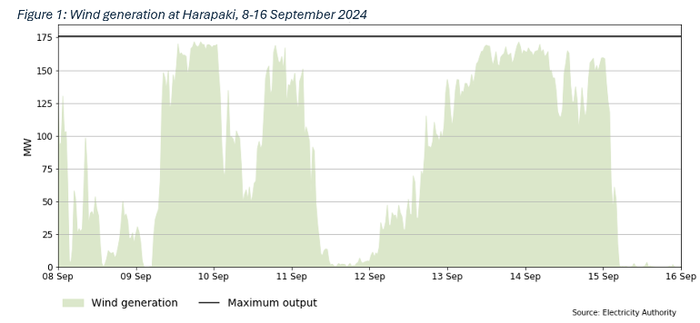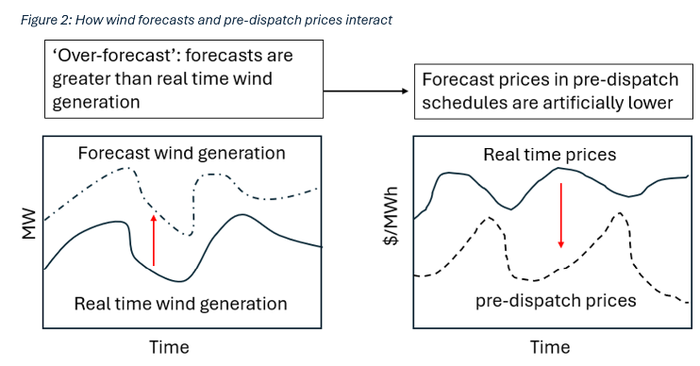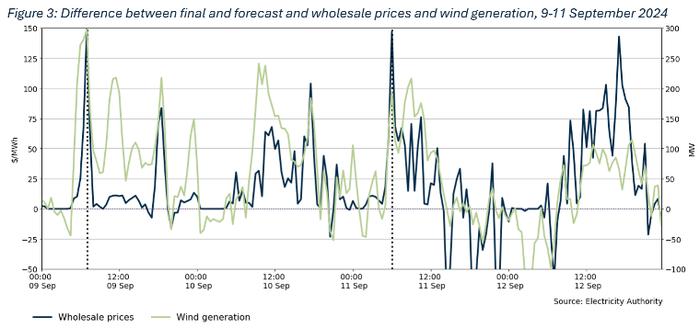Eye on electricity
Changes to wind and solar forecasting set to improve electricity system reliability
- Generation
New Zealand is transitioning to a highly renewable electricity system. Currently, 11% of installed generation capacity is wind generation and less than 1% is solar generation. However, this will increase as most new generation will be either solar or wind farms, which are ‘intermittent’, meaning power output varies with time.
Intermittent generation is reliant on forecasts to allow the electricity system to operate reliably and efficiently. This article explains how the Electricity Authority Te Mana Hiko (Authority) has developed a new hybrid forecasting arrangement for intermittent generators, and how this change will benefit New Zealand’s increasingly renewable electricity system.
Forecasting intermittent generation is critical to managing the power system
The installed capacity of a wind/solar farm is often several dozen megawatts, however, its output varies with the weather and/or time of day. For example, between 8-16 September the output of Harapaki, a Meridian wind farm with a capacity of 176MW, varied from 0MW to 175MW (see Figure 1).

The effective forecasting of intermittent generation is critical to managing a highly renewable power system. When intermittent generation is high, other generation like hydro and thermal (which may run on green fuels in the future) can back off and save fuel. But when intermittent generation dips, these fuels must be ready to make up the difference to meet demand.
The growing proportion of intermittent generation is facilitating the transition to a low carbon economy. However, there must be systems for dealing with the ebbs and flows of intermittent generation, to ensure the reliability of the electricity system.
Wholesale electricity prices often spike when wind forecasts are inaccurate
The electricity system in New Zealand is largely organised around the wholesale electricity price, which is determined every half hour by the available supply and demand for electricity.
Wholesale price forecasts, referred to as the pre-dispatch price, are produced by the system operator leading up to each half-hourly trading period. The pre-dispatch price signals to generators whether their units are required to meet expected demand - and the likely wholesale price they will receive if they do run. Wind forecasts1 can impact pre-dispatch prices in two ways.
Firstly, if wind generation is over-forecast, which occurs when wind generation is lower than forecasts predict, this can artificially lower pre-dispatch prices. This is shown in Figure 2. These low prices signal to some generators that they may not be needed, and particularly thermal generators may price their units high, to reflect the cost of running their units for only a short time if required.

Therefore, when wind is over-forecast, there is a real time ‘shortfall’ in wind generation. High-priced thermal or hydro generators may then get dispatched to cover this ‘shortfall’, resulting in a higher wholesale electricity price.
For example, on 11 September 2024, wholesale prices spiked above their final pre-dispatch value (blue line) when wind generation was over-forecast (green line) (see Figure 2). Large differences between forecast and final wholesale prices occurred at 7am on 9 September and 6am on 11 September (black highlights in Figure 3), in both instances the wind forecasts were over 90MW greater than actual wind generation.

Secondly, if wind is under-forecast, meaning there is more wind than initially expected, the pre-dispatch price is artificially higher, which signals to more generators they will be needed to meet demand.
So, when wind generation is under-forecast, this can result in coordination problems, where some generators may need to curtail generation. This may be uneconomic for some generators.
Both instances highlight the importance that accurate wind forecasts play in coordinating the electricity market, through correctly indicating the likely final price in the forecast price schedules.
There are currently no requirements around the accuracy and frequency of intermittent generation offers more than two hours ahead of a trading period
Requirements that apply to intermittent generators are outlined in the Electricity Industry Participation Code 2010. The Authority last updated these requirements in 2019, when installed wind farms only totaled 6% of New Zealand’s electricity capacity.
Intermittent generators are currently required to submit initial generation offers at least 71 trading periods (35.5 hours) ahead of time based on a reasonable expectation of how much they can generate. Then two hours before real time, offers must be based on a resource persistence model2 and must be revised every 30 minutes. For persistence wind forecasting, the forecast is essentially a two-hour shift of the actual wind output, which leads to large errors when wind output is rapidly increasing or decreasing (see Figure 4).

Currently, there are no regulatory consequences for inaccurate intermittent generation forecasts and offers before of two hours ahead of real time. Therefore, some intermittent generators are not incentivised to improve the accuracy of their forecasts.
The new hybrid forecasting arrangement will encourage better generator performance and maintain forecast accuracies
In 2022 the Authority began investigating the impacts of inaccurate wind forecasting on the electricity system.
In July 2024 the Authority released a decision paper indicating that it will implement a hybrid forecasting arrangement. This new system will provide a centrally procured forecast of intermittent generation for each generation site. Intermittent generators will be able to submit offers using their own forecast if their forecast is consistently at least as accurate as the centralised forecast.
On 11 October 2024 the Authority published a consultation paper on the proposed Code changes required for the hybrid arrangement. The Authority is aiming to have a hybrid arrangement in place by winter 2025.
The Authority will also introduce new accuracy standards, which will incentivise the centralised forecaster and intermittent generators to ensure their forecasts and offers are as accurate as possible.
As part of the Authority’s measures to incentivise improvements in forecasting accuracy, we are publishing monthly data on the performance3 of the forecasts of individual wind farms.
More accurate forecasts will increase the accuracy of pre-dispatch prices, which ensures the most efficient and lowest cost generation is being dispatched. This is a key initiative to support affordable electricity for consumers from a highly renewable electricity system.
The hybrid forecasting arrangement will encourage new innovations in forecasting
The hybrid forecasting arrangement supports the development of a market for intermittent generation forecasting and will foster innovation through creating competitive tension between the centralised forecaster and other forecasting providers. This could improve the quality of both approaches.
Innovator-developers will benefit as the hybrid arrangement supports competition by reducing regulatory and information barriers to participation by new entrants.
Overall, the new arrangement will provide more accurate information and improve the operation of the electricity system. Improving the reliability and efficiency of the electricity market will benefit all electricity users.
1. Currently the proportion of solar generation is too low to significantly impact wholesale electricity prices, however, as solar output grows its variation from forecasts will likely impact price signals similarly to wind.
2. In a resource persistence model, future wind power will be the same value as in the present time the wind offer was submitted.
3. The root mean square error is calculated for each wind farm (with smaller values indicating a more accurate forecast). The mean bias error shows if the wind farm tended to over or underestimate its final wind generation.
Related News
Strong inflows push hydro storage above nominal full
Rainy spring weather and snowmelt have caused national hydro storage in New Zealand to increase beyond ‘nominal full’ capacity - and to its highest level since…
Wholesale prices plummet as the proportion of renewables increases
Wholesale electricity prices dropped dramatically in just two months - from over $280/MWh in late August 2025 to an average of $30/MWh in October 2025, the low…
Proposal to collect and publish energy margin information
We want to collect and publish information on generators’ energy margins, and we want to hear your views about our proposed approach.